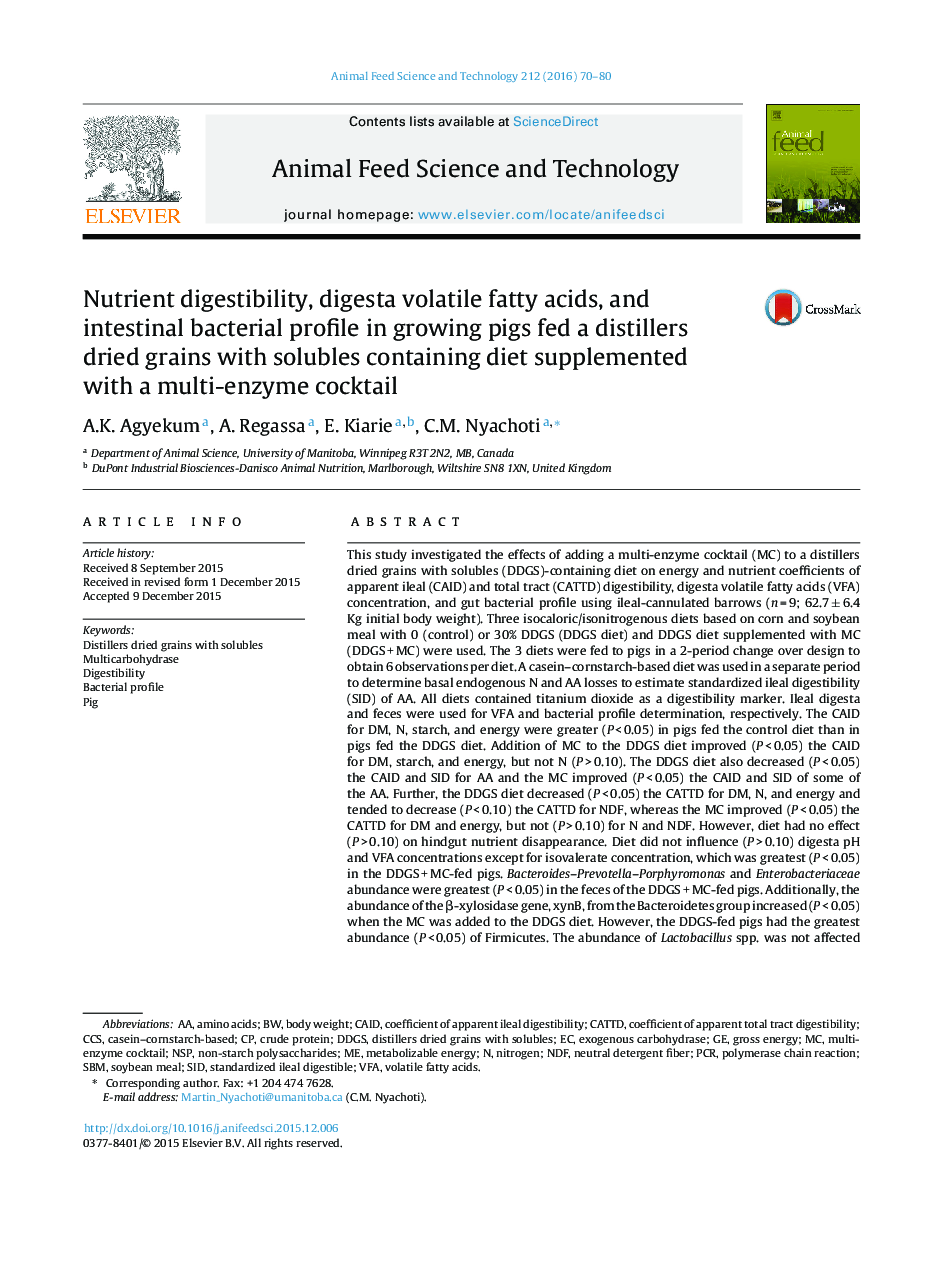| Article ID | Journal | Published Year | Pages | File Type |
|---|---|---|---|---|
| 8491276 | Animal Feed Science and Technology | 2016 | 11 Pages |
Abstract
This study investigated the effects of adding a multi-enzyme cocktail (MC) to a distillers dried grains with solubles (DDGS)-containing diet on energy and nutrient coefficients of apparent ileal (CAID) and total tract (CATTD) digestibility, digesta volatile fatty acids (VFA) concentration, and gut bacterial profile using ileal-cannulated barrows (n = 9; 62.7 ± 6.4 Kg initial body weight). Three isocaloric/isonitrogenous diets based on corn and soybean meal with 0 (control) or 30% DDGS (DDGS diet) and DDGS diet supplemented with MC (DDGS + MC) were used. The 3 diets were fed to pigs in a 2-period change over design to obtain 6 observations per diet. A casein-cornstarch-based diet was used in a separate period to determine basal endogenous N and AA losses to estimate standardized ileal digestibility (SID) of AA. All diets contained titanium dioxide as a digestibility marker. Ileal digesta and feces were used for VFA and bacterial profile determination, respectively. The CAID for DM, N, starch, and energy were greater (P < 0.05) in pigs fed the control diet than in pigs fed the DDGS diet. Addition of MC to the DDGS diet improved (P < 0.05) the CAID for DM, starch, and energy, but not N (P > 0.10). The DDGS diet also decreased (P < 0.05) the CAID and SID for AA and the MC improved (P < 0.05) the CAID and SID of some of the AA. Further, the DDGS diet decreased (P < 0.05) the CATTD for DM, N, and energy and tended to decrease (P < 0.10) the CATTD for NDF, whereas the MC improved (P < 0.05) the CATTD for DM and energy, but not (P > 0.10) for N and NDF. However, diet had no effect (P > 0.10) on hindgut nutrient disappearance. Diet did not influence (P > 0.10) digesta pH and VFA concentrations except for isovalerate concentration, which was greatest (P < 0.05) in the DDGS + MC-fed pigs. Bacteroides-Prevotella-Porphyromonas and Enterobacteriaceae abundance were greatest (P < 0.05) in the feces of the DDGS + MC-fed pigs. Additionally, the abundance of the β-xylosidase gene, xynB, from the Bacteroidetes group increased (P < 0.05) when the MC was added to the DDGS diet. However, the DDGS-fed pigs had the greatest abundance (P < 0.05) of Firmicutes. The abundance of Lactobacillus spp. was not affected (P > 0.10) by diet. In conclusion, adding MC to the DDGS diet improved the digestibility of DM, starch, most AA, but not NDF and N digestibility. The results show that addition of MC to the DDGS diet stimulated the growth of intestinal bacteria with xylanolytic and cellulolytic activities.
Keywords
CAIDStandardized ileal digestibleVFACCSCATTDNDFSBMDDGSNSPAmino acidsVolatile fatty acidsMetabolizable energygross energyPigdistillers dried grains with solublesSiDcoefficient of apparent ileal digestibilitycoefficient of apparent total tract digestibilityneutral detergent fiberDigestibilityNitrogenpolymerase chain reactionPCRbody weightcrude proteinnon-starch polysaccharidesSoybean meal
Related Topics
Life Sciences
Agricultural and Biological Sciences
Animal Science and Zoology
Authors
A.K. Agyekum, A. Regassa, E. Kiarie, C.M. Nyachoti,
